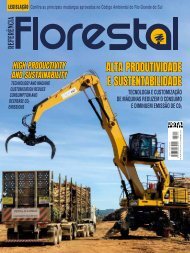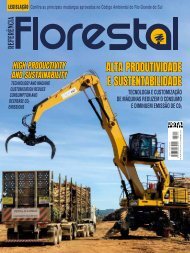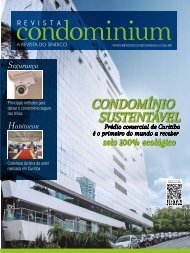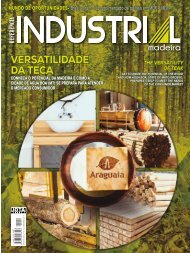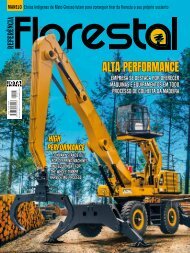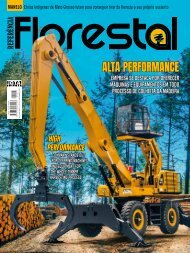Dezembro/2017 - Referência Florestal 192
Visitantes - Grupo Jota Comunicação
Visitantes - Grupo Jota Comunicação
Create successful ePaper yourself
Turn your PDF publications into a flip-book with our unique Google optimized e-Paper software.
para obtenção de florestas mais rentáveis, muitas vezes ignorada,<br />
é a determinação da idade ótima econômica de corte,<br />
que varia de uma floresta para outra. A adoção de idades não<br />
ótimas resulta em perdas econômicas para o produtor.<br />
Quais regiões estão se destacando e que devem estar no<br />
radar do silvicultor?<br />
Acredito que quase todas as regiões do Brasil apresentam<br />
um forte potencial, desde que observadas as boas práticas de<br />
planejamento florestal. As novas usinas de etanol de milho no<br />
Mato Grosso, a possibilidade da inserção da energia de biomassa<br />
florestal nos leilões de energia, a demanda por madeira<br />
para uso energético na agricultura, a expansão dos projetos<br />
de celulose e papel e o desenvolvimento de novos produtos<br />
nas biorrefinarias nas regiões florestais já consolidadas e no<br />
Mato Grosso do Sul, Maranhão e Bahia, uma maior adoção<br />
de madeira de florestas plantadas para construção civil e para<br />
fabricação de móveis são todos bons indícios para a cadeia<br />
produtiva florestal. Aproveitar este potencial dependerá da<br />
compreensão de cada negócio e da floresta como um ativo<br />
biológico capaz de ofertar múltiplos produtos que podem<br />
otimizar o seu retorno em diferentes mercados, não apenas<br />
como produtora de biomassa.<br />
Existem algumas armadilhas no negócio? Poderia citar as<br />
mais usuais e que as pessoas, às vezes, não se dão conta?<br />
A principal é o desconhecimento do mercado e a implantação<br />
de florestas sem o devido planejamento estratégico (de longo<br />
prazo). Analisar o investimento desconsiderando os custos de<br />
colheita e transporte até o cliente, adequados a sua escala<br />
de produção, seria a segunda. A terceira seria depender de<br />
um único consumidor para o seu produto, sem que haja um<br />
relacionamento comercial que possibilite a redução do risco<br />
de ambos.<br />
Existe alguma espécie promissora, excluindo as estabelecidas<br />
como pinus e eucalipto?<br />
Há várias em estudo - cedro australiano, mogno africano, teca<br />
e outras folhosas - voltadas principalmente para a produção de<br />
madeira de maior valor agregado. Mas a execução do planejamento<br />
adequado da atividade antes de realizar a implantação<br />
é necessária, independente da espécie selecionada.<br />
strategy play a more important role. A powerful tool for obtaining<br />
more profitable forests, often ignored, is the determination<br />
of the optimum economic cutting age, which varies<br />
from one forest to another. The adoption of a non-optimum<br />
ages results in an economic loss to the producer.<br />
Which regions stand out that should be on the radar of the<br />
forest producer?<br />
I believe that almost all regions in Brazil have a strong potential,<br />
as long as the best practices in forest planning are used.<br />
The new corn ethanol plants in the State of Mato Grosso, the<br />
possibility of the forest biomass energy be included the energy<br />
auctions, the demand for timber for energy use in agriculture,<br />
the expansion of the pulp and paper projects, and the<br />
development of new products in bio refineries in already consolidated<br />
forest regions and in the States of Mato Grosso do<br />
Sul, Maranhão and Bahia, and the greater use of timber from<br />
planted forests for construction and furniture manufacturing<br />
are all good signs for the forest productive chain. Taking advantage<br />
of this potential will depend on the understanding of<br />
each business and the forest as a biological asset able to offer<br />
multiple products that can optimize its return in different<br />
markets, not only as a producer of biomass.<br />
Are there pitfalls in the business? Could you cite the more<br />
usual and the people who sometimes didn’t take adequate<br />
care?<br />
The main one is a lack of knowledge about the market and<br />
the implementation of a forest without due strategic planning<br />
(long-term). Analyzing the investment regardless of harvesting<br />
and transportation costs to the customer, suitability as to<br />
scale of production, would be the second. The third would be<br />
dependence on a single consumer for the product without a<br />
business relationship that allows the reduction of risk to both.<br />
Are there any promising species, excluding the established<br />
such as pine and eucalyptus?<br />
There are several studies being carried out – for Australian<br />
cedar, African mahogany, teak and other hardwoods - geared<br />
primarily to higher value added timber production. But the<br />
execution of proper planning for the activity before installation<br />
is needed, independent of the species selected.<br />
Espécies novas apresentam um desafio adicional quando<br />
comparadas às espécies consolidadas (pinus e eucalipto)<br />
em relação à carência de informações e materiais genéticos<br />
adaptados e de elevada produtividade<br />
<strong>Dezembro</strong> de <strong>2017</strong> REVISTA REFERÊNCIA FLORESTAL<br />
31




